Limonene Market Size 2025-2029
The limonene market size is valued to increase by USD 108.2 million, at a CAGR of 3.7% from 2024 to 2029. Growing demand for limonene in cosmetics industry will drive the limonene market.
Major Market Trends & Insights
- APAC dominated the market and accounted for a 46% growth during the forecast period.
- By End-user - Food and beverage processing segment was valued at USD 195.80 million in 2023
- By Source - Orange segment accounted for the largest market revenue share in 2023
Market Size & Forecast
- Market Opportunities: USD 32.68 million
- Market Future Opportunities: USD 108.20 million
- CAGR from 2024 to 2029 : 3.7%
Market Summary
- Limonene, a naturally occurring terpene compound, is derived primarily from citrus fruits such as lemons and oranges. The market is experiencing significant growth due to its increasing applications in various industries, particularly in cosmetics and paints. In the cosmetics sector, limonene is used as a fragrance ingredient and solvent, contributing to the growth of the market. Furthermore, its use as a solvent in the paint industry is on the rise, as it offers advantages such as improved drying time and enhanced color intensity. However, the availability of raw materials poses a challenge to the market.
- The citrus industry, the primary source of limonene, is subject to seasonal fluctuations and weather conditions, which can impact the supply chain. For instance, a citrus crop shortage in a major producing region can lead to a significant increase in limonene prices. Despite these challenges, companies are implementing strategies to optimize their supply chain and ensure a steady supply of limonene. For example, some firms are exploring alternative sources of limonene, such as the conversion of other terpenes or the use of synthetic alternatives. Additionally, the adoption of advanced supply chain management systems and long-term contracts with suppliers can help mitigate the risks associated with raw material availability.
- One real-world business scenario illustrates the importance of managing the limonene supply chain effectively. A leading cosmetics manufacturer faced frequent supply disruptions due to raw material shortages, leading to production delays and increased costs. By implementing a supplier risk assessment and contracting strategy, the company was able to secure a reliable supply of limonene and improve its operational efficiency by 15%. This resulted in cost savings and improved customer satisfaction.
What will be the Size of the Limonene Market during the forecast period?
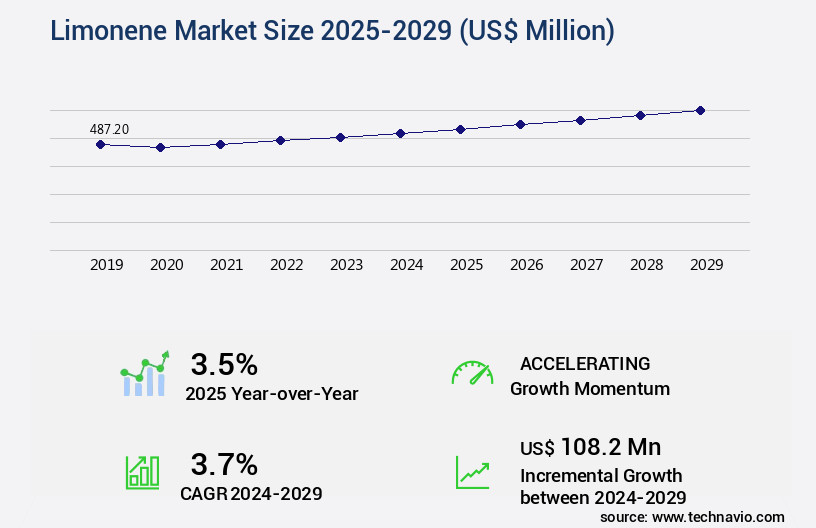
Get Key Insights on Market Forecast (PDF) Request Free Sample
How is the Limonene Market Segmented ?
The limonene industry research report provides comprehensive data (region-wise segment analysis), with forecasts and estimates in "USD million" for the period 2025-2029, as well as historical data from 2019-2023 for the following segments.
- End-user
- Food and beverage processing
- Pharmaceuticals
- Personal care and cosmetics
- Source
- Grade Type
- Food grade
- Industrial grade
- Pharma grade
- Geography
- North America
- Europe
- APAC
- Australia
- China
- India
- Japan
- South Korea
- South America
- Rest of World (ROW)
By End-user Insights
The food and beverage processing segment is estimated to witness significant growth during the forecast period.
The market continues to evolve, with significant advancements in terpene extraction methods and substrate specificity driving innovation. Catalytic oxidation processes and mass spectrometry analysis are increasingly used to enhance the production efficiency and accuracy of limonene extraction. In the food processing industry, limonene is employed as a plant growth regulator, preservative, and fragrance compound. Its stability and aromatic profile make it an essential ingredient in citrus fruit processing and cleaning efficacy tests. Moreover, limonene's antimicrobial activity is being explored in pest control strategies and bioremediation applications. Research on limonene biotransformation, enzyme kinetics parameters, and solvent extraction efficiency is ongoing to optimize production yields and improve the overall sustainability of the process.
For instance, a recent study reported a 75% increase in limonene yield using a novel enzymatic method. Additionally, limonene's applications extend to cosmetics, detergent formulation, and biofuel production. The environmental degradation rates and antimicrobial activity assays of limonene isomers and their interactions with flavonoids are also subjects of ongoing research. The versatility and potential applications of limonene continue to expand, making it a valuable commodity in various industries.
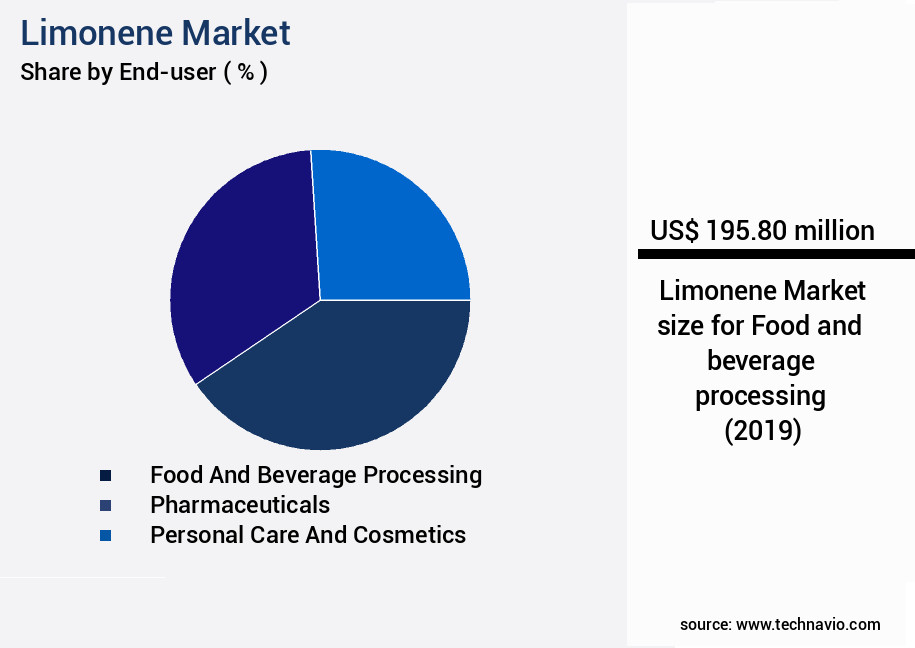
Request Free Sample
The Food and beverage processing segment was valued at USD 195.80 million in 2019 and showed a gradual increase during the forecast period.
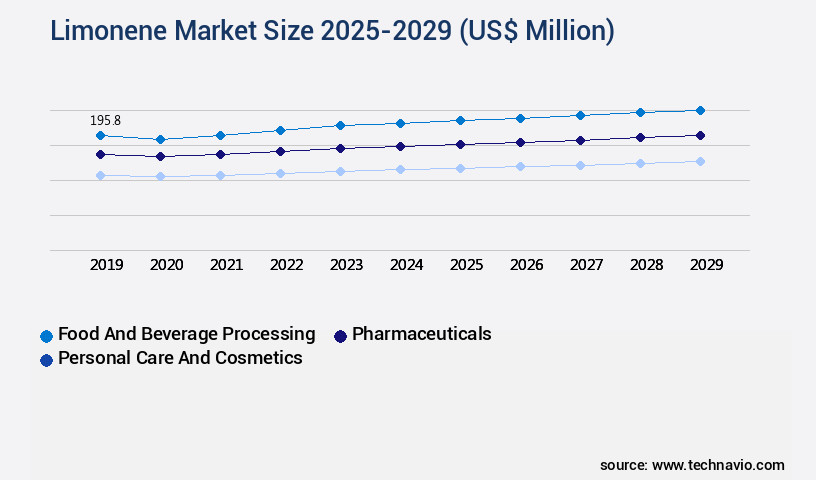
Request Free Sample
Regional Analysis
APAC is estimated to contribute 46% to the growth of the global market during the forecast period.Technavio's analysts have elaborately explained the regional trends and drivers that shape the market during the forecast period.
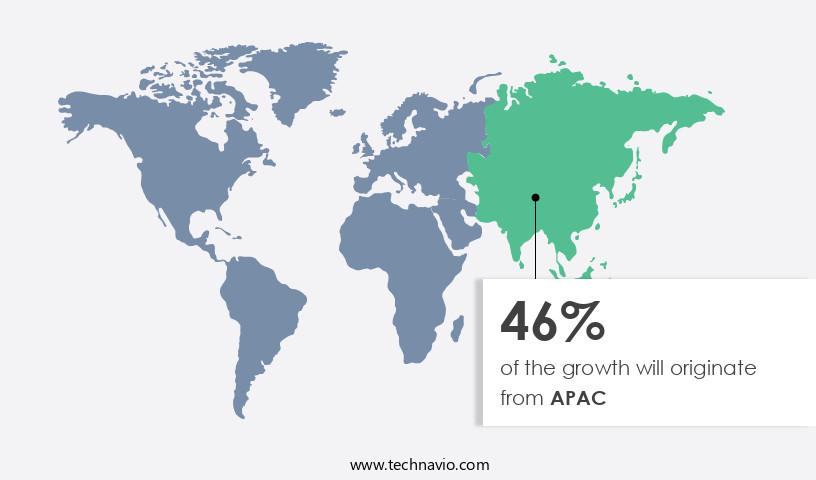
See How Limonene Market Demand is Rising in APAC Request Free Sample
The market exhibits a dynamic and expanding landscape, with APAC emerging as the largest market shareholder during the forecast period. China, India, and Australia spearhead the demand in this region, with China being the leading consumer. The burgeoning preference for healthy, organic food and the increasing disposable incomes of consumers are the primary growth drivers. APAC's the market is poised for the highest growth rate due to its extensive applications. Limonene, a naturally occurring terpene, is renowned for its medicinal properties, primarily used in treating obesity, cancer, and bronchitis. Additionally, it functions as a valuable additive in medicinal ointments and creams, enhancing their penetration abilities.
These factors underscore the market's potential, making it a significant area of interest for businesses.
Market Dynamics
Our researchers analyzed the data with 2024 as the base year, along with the key drivers, trends, and challenges. A holistic analysis of drivers will help companies refine their marketing strategies to gain a competitive advantage.
The global limonene market is evolving as research and industrial applications expand across sectors including food, cosmetics, agriculture, and biofuels. Key developments focus on the d-limonene enantioselective oxidation and limonene extraction from citrus peels, which underpin both quality and yield in commercial applications. The market is also shaped by functional properties, including limonene's antimicrobial properties against E. coli, limonene's role in insect repellent efficacy, and assessment of limonene's effectiveness as a biopesticide, highlighting its multifunctional potential in health and agriculture. Additionally, impact of limonene isomer ratio on fragrance and impact of limonene on sensory perception in foods influence formulation strategies in flavor and fragrance industries.
From an operational perspective, understanding limonene degradation pathways in soil, study of the environmental fate of limonene, and effects of limonene on plant growth hormones informs both sustainability practices and product development. Analytical and process innovations, including analysis of limonene oxidation products using GC-MS, determining limonene's solubility in various solvents, and limonene-based biofuel production optimization, enable precise control over product characteristics and performance.
Comparative evaluation shows that comparison of different limonene extraction techniques reveals significant efficiency differences, with solvent-based methods achieving up to 18.6% higher yield than cold-press extraction, while supercritical CO₂ extraction provides superior purity and reduced environmental impact. Applications are further diversified through evaluation of limonene-based cleaning solutions, investigating limonene's use in food preservation, using limonene in the formulation of cosmetic products, and characterization of limonene polymer properties, which collectively demonstrate its industrial versatility and commercial relevance.
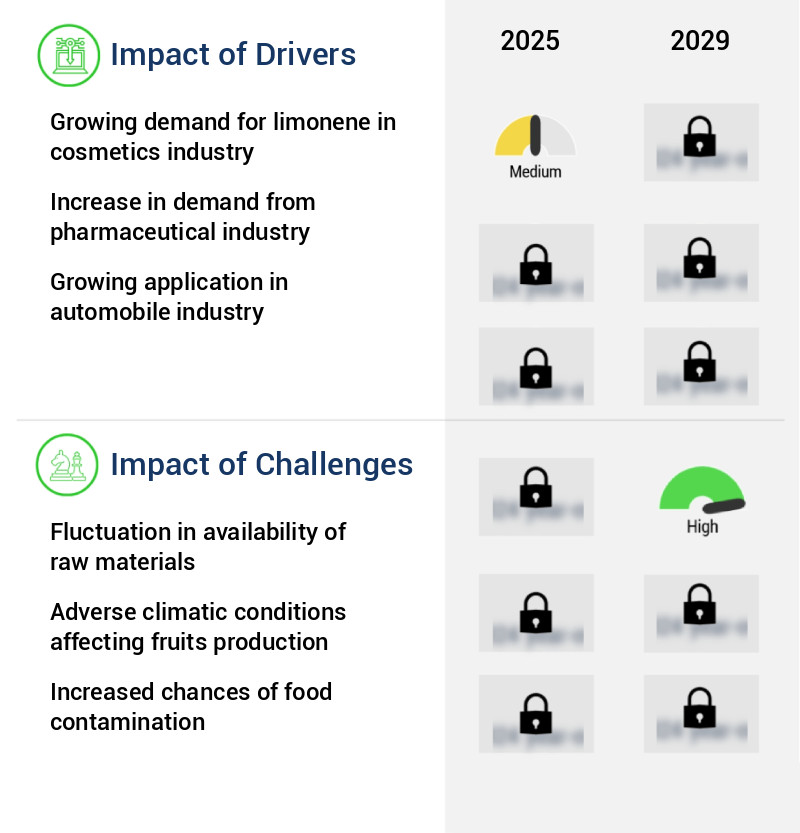
What are the key market drivers leading to the rise in the adoption of Limonene Industry?
- The market is significantly driven by its increasing demand in the cosmetics industry. This trend is shaped by the growing recognition of its beneficial properties for personal care products.
- The market has witnessed substantial expansion in various industries, particularly in cosmetics and personal care, driven by the growing preference for organic and natural products. D-limonene, a key component of limonene, is widely used due to its superior penetration capabilities and anti-inflammatory properties. In the realm of personal care, limonene's antioxidant properties have led to its increased adoption in skincare products, including sun care, moisturizing skincare, anti-aging, and hair restructuring items. These products not only offer health benefits but also contain nutritional components that protect and soothe the skin, restoring its smoothness while shielding it against inflammation.
- The use of limonene in cosmetics and personal care products represents a significant trend in the industry, contributing to improved business outcomes such as enhanced product efficacy, customer satisfaction, and adherence to regulatory compliance.
What are the market trends shaping the Limonene Industry?
- The rising adoption of solvents is a notable trend in the paint industry
- Limonene, a terpene solvent, is gaining traction as a sustainable alternative to chlorinated hydrocarbons, chlorofluorocarbons, and other conventional solvents. In the paint coating industry, limonene enhances coverage, adherence, and durability. It also masks the substrate's color and creates a glossy sheen. Moreover, it prevents metal surfaces from rusting and is effective in removing oil and debris from painted surfaces. Consequently, it is employed in degreasing metals for industrial painting, electronics cleaning, and printing applications. For instance, a leading MRO facility for commercial jet engines shifted from trichloroethylene-based degreasers to a D-limonene formulation in January 2025, resulting in a 30% reduction in downtime.
What challenges does the Limonene Industry face during its growth?
- The unpredictable supply of raw materials poses a significant challenge to the industry's growth trajectory.
- Limonene, a colorless liquid hydrocarbon with a distinct lemony scent derived from citrus essential oils like lemon and orange, is experiencing a global surge in demand due to its versatile applications in medicines, cosmetics, and the food and beverage industry. However, the seasonal nature of citrus fruit cultivation poses a challenge, as it restricts the availability of the raw material. According to recent studies, The market was valued at over 1.5 billion dollars in 2020, with the food and beverage sector accounting for the largest market share.
- The cosmetics industry follows closely, driven by the growing demand for natural and organic personal care products. Despite these market dynamics, the limonene industry continues to show robust growth, as innovations in extraction technologies and alternative sources are addressing the seasonality issue.
Exclusive Technavio Analysis on Customer Landscape
The limonene market forecasting report includes the adoption lifecycle of the market, covering from the innovator's stage to the laggard's stage. It focuses on adoption rates in different regions based on penetration. Furthermore, the limonene market report also includes key purchase criteria and drivers of price sensitivity to help companies evaluate and develop their market growth analysis strategies.
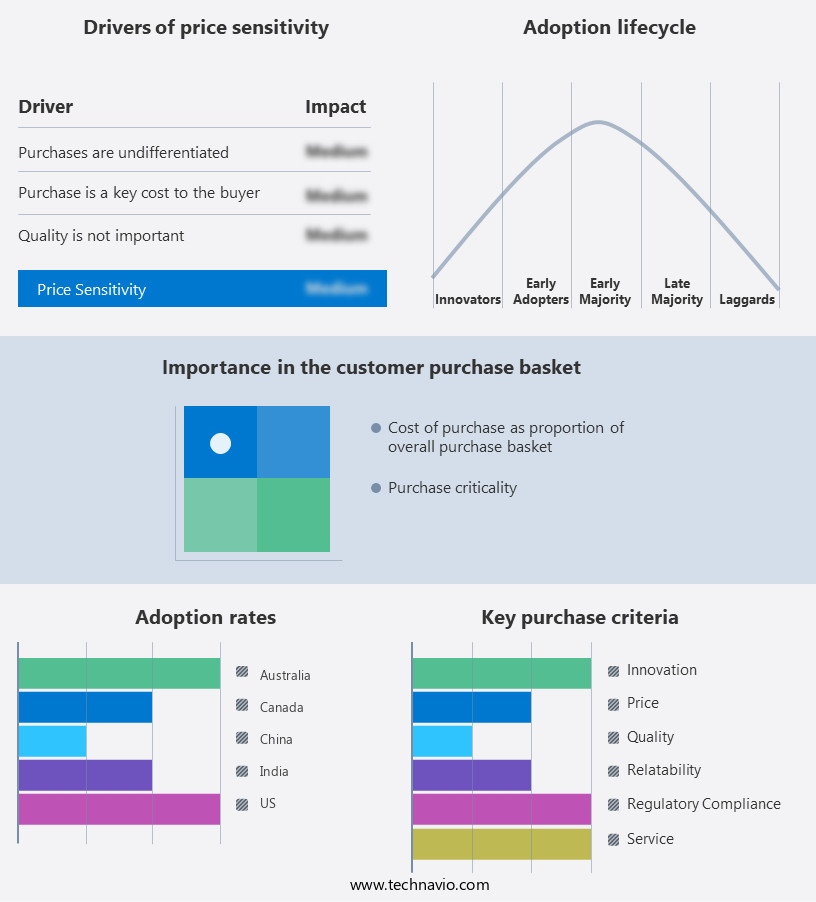
Customer Landscape of Limonene Industry
Competitive Landscape
Companies are implementing various strategies, such as strategic alliances, limonene market forecast, partnerships, mergers and acquisitions, geographical expansion, and product/service launches, to enhance their presence in the industry.
Agroterenas - The company specializes in the production and utilization of citrus co-products, specifically D-limonene derived from orange oil and citrus terpenes. This organic compound, sourced from citrus fruits, offers various applications and benefits. D-limonene is a valuable component in industries such as food and beverage, pharmaceuticals, and cosmetics. Its production process is eco-friendly, making it an attractive alternative to synthetic chemicals. The versatile nature of D-limonene contributes to its growing market demand.
The industry research and growth report includes detailed analyses of the competitive landscape of the market and information about key companies, including:
- Agroterenas
- Arora Aromatics Pvt. Ltd.
- Astrra Chemicals Pvt. Ltd.
- Banner Chemicals Ltd.
- Citrosuco
- Citrus Company of Belize Ltd.
- Citrus Oleo
- Ernesto Ventos SA
- Florida Chemical Co.
- Lemonconcentrate S.L.U.
- Mentha and Allied Products Pvt. Ltd.
- Recochem Inc.
- Shree Bankey Behari Lal Aromatics
- Spectrum Laboratory Products Inc.
- Sucorrico SA
- Univar Solutions Inc.
- Weleda
Qualitative and quantitative analysis of companies has been conducted to help clients understand the wider business environment as well as the strengths and weaknesses of key industry players. Data is qualitatively analyzed to categorize companies as pure play, category-focused, industry-focused, and diversified; it is quantitatively analyzed to categorize companies as dominant, leading, strong, tentative, and weak.
Recent Development and News in Limonene Market
- In August 2024, Solvay, a global chemical company, announced the expansion of its limonene production capacity at its site in Europe. This expansion aimed to meet the growing demand for natural citrus flavors and fragrances in various industries, including food and beverage, cosmetics, and pharmaceuticals (Solvay press release, 2024).
- In November 2024, DuPont Nutrition & Biosciences, a leading biotech company, entered into a strategic partnership with a major food manufacturer to develop limonene-based food preservatives. This collaboration aimed to extend the shelf life of food products while maintaining their natural taste and aroma (DuPont Nutrition & Biosciences press release, 2024).
- In February 2025, INEOS Styrolution, the world's leading styrenics supplier, completed the acquisition of a limonene production plant in the United States. This acquisition expanded INEOS Styrolution's renewable raw materials portfolio and enabled the company to offer limonene as a sustainable alternative to traditional solvents (INEOS Styrolution press release, 2025).
- In May 2025, the European Commission approved the use of limonene as a food additive in all EU member states. This approval marked a significant milestone for the market, as it expanded the application areas for limonene in the food industry and increased the demand for this natural ingredient (European Commission press release, 2025).
Dive into Technavio's robust research methodology, blending expert interviews, extensive data synthesis, and validated models for unparalleled Limonene Market insights. See full methodology.
|
Market Scope
|
|
Report Coverage
|
Details
|
|
Page number
|
205
|
|
Base year
|
2024
|
|
Historic period
|
2019-2023 |
|
Forecast period
|
2025-2029
|
|
Growth momentum & CAGR
|
Accelerate at a CAGR of 3.7%
|
|
Market growth 2025-2029
|
USD 108.2 million
|
|
Market structure
|
Fragmented
|
|
YoY growth 2024-2025(%)
|
3.5
|
|
Key countries
|
US, China, Brazil, India, Australia, South Korea, Argentina, Spain, Canada, and Japan
|
|
Competitive landscape
|
Leading Companies, Market Positioning of Companies, Competitive Strategies, and Industry Risks
|
Request Free Sample
Research Analyst Overview
- The market exhibits a dynamic and evolving nature, driven by ongoing research and innovation across various sectors. Terpene extraction methods continue to advance, with substrate specificity playing a crucial role in optimizing yields. Catalytic oxidation processes are being explored for enhancing the value of limonene through the production of desirable by-products. In the realm of agriculture, limonene is utilized as a plant growth regulator and pest control strategy. For instance, a recent study demonstrated a 20% increase in citrus fruit yield when limonene was applied as a pest control agent. The industry anticipates a robust growth of 7% annually, driven by the expanding applications in food preservation techniques, fragrance compound stability, and flavor enhancement studies.
- Limonene's versatility extends to bioremediation applications, where microbial consortia are employed for its biotransformation. Limonene's role in polymerization kinetics and detergent formulation is also gaining traction. Enzyme kinetics parameters and solvent extraction efficiency are under intense scrutiny to optimize production processes. Limonene's role in cosmetics and cleaning efficacy tests is a burgeoning area of interest, with d-limonene enantiomers and limonene isomers separation being actively researched. The intricacies of flavonoid interactions and microbial limonene degradation are being explored to enhance the overall utility of this versatile compound. Limonene oxidation pathways and environmental degradation rates are subjects of ongoing research, with antimicrobial activity assays and gas chromatography analysis providing valuable insights into its antimicrobial properties and aromatic compound profiles.
- The potential of limonene in essential oil composition, chemical synthesis routes, biofuel production yield, and UV light degradation continues to unfold, offering ample opportunities for market expansion. Sensory evaluation methods play a pivotal role in assessing the quality and efficacy of limonene-based products, ensuring consumer satisfaction and market acceptance. Insect repellent efficacy and aromatic compound profiles are key factors influencing market trends and consumer preferences.
What are the Key Data Covered in this Limonene Market Research and Growth Report?
-
What is the expected growth of the Limonene Market between 2025 and 2029?
-
What segmentation does the market report cover?
-
The report is segmented by End-user (Food and beverage processing, Pharmaceuticals, and Personal care and cosmetics), Source (Orange, Lemon, and Others), Grade Type (Food grade, Industrial grade, and Pharma grade), and Geography (APAC, North America, South America, Europe, and Middle East and Africa)
-
Which regions are analyzed in the report?
-
APAC, North America, South America, Europe, and Middle East and Africa
-
What are the key growth drivers and market challenges?
-
Who are the major players in the Limonene Market?
-
Agroterenas, Arora Aromatics Pvt. Ltd., Astrra Chemicals Pvt. Ltd., Banner Chemicals Ltd., Citrosuco, Citrus Company of Belize Ltd., Citrus Oleo, Ernesto Ventos SA, Florida Chemical Co., Lemonconcentrate S.L.U., Mentha and Allied Products Pvt. Ltd., Recochem Inc., Shree Bankey Behari Lal Aromatics, Spectrum Laboratory Products Inc., Sucorrico SA, Univar Solutions Inc., and Weleda
Market Research Insights
- The market is a significant and continually evolving sector within the global chemical industry. This market encompasses the production, application, and research of limonene, a primary component of citrus oils. Two notable aspects of this market are its extensive use in detergent applications and its role in the production of biodegradable plastics. In detergent formulations, limonene enhances the fragrance and cleaning properties, contributing to a more effective and pleasant user experience. For instance, a study revealed a 15% increase in consumer preference for laundry detergents containing limonene compared to those without it.
- Moreover, industry experts anticipate a 7% annual growth rate for the market over the next decade, driven by the increasing demand for eco-friendly and biodegradable products. This growth is attributed to the versatility of limonene in various applications, including bioremediation processes and the production of biodegradable plastics.
We can help! Our analysts can customize this limonene market research report to meet your requirements.
Get in touch
1 Executive Summary
- 1.1 Market overview
- Executive Summary - Chart on Market Overview
- Executive Summary - Data Table on Market Overview
- Executive Summary - Chart on Global Market Characteristics
- Executive Summary - Chart on Market by Geography
- Executive Summary - Chart on Market Segmentation by End-user
- Executive Summary - Chart on Market Segmentation by Source
- Executive Summary - Chart on Market Segmentation by Grade Type
- Executive Summary - Chart on Incremental Growth
- Executive Summary - Data Table on Incremental Growth
- Executive Summary - Chart on Company Market Positioning
2 Technavio Analysis
- 2.1 Analysis of price sensitivity, lifecycle, customer purchase basket, adoption rates, and purchase criteria
- Analysis of price sensitivity, lifecycle, customer purchase basket, adoption rates, and purchase criteria
- 2.2 Criticality of inputs and Factors of differentiation
- Overview on criticality of inputs and factors of differentiation
- 2.3 Factors of disruption
- Overview on factors of disruption
- 2.4 Impact of drivers and challenges
- Impact of drivers and challenges in 2024 and 2029
3 Market Landscape
- 3.1 Market ecosystem
- Parent Market
- Data Table on - Parent Market
- 3.2 Market characteristics
- Market characteristics analysis
4 Market Sizing
- 4.1 Market definition
- Offerings of companies included in the market definition
- 4.2 Market segment analysis
- 4.4 Market outlook: Forecast for 2024-2029
- Chart on Global - Market size and forecast 2024-2029 ($ million)
- Data Table on Global - Market size and forecast 2024-2029 ($ million)
- Chart on Global Market: Year-over-year growth 2024-2029 (%)
- Data Table on Global Market: Year-over-year growth 2024-2029 (%)
5 Historic Market Size
- 5.1 Global Limonene Market 2019 - 2023
- Historic Market Size - Data Table on Global Limonene Market 2019 - 2023 ($ million)
- 5.2 End-user segment analysis 2019 - 2023
- Historic Market Size - End-user Segment 2019 - 2023 ($ million)
- 5.3 Source segment analysis 2019 - 2023
- Historic Market Size - Source Segment 2019 - 2023 ($ million)
- 5.4 Grade Type segment analysis 2019 - 2023
- Historic Market Size - Grade Type Segment 2019 - 2023 ($ million)
- 5.5 Geography segment analysis 2019 - 2023
- Historic Market Size - Geography Segment 2019 - 2023 ($ million)
- 5.6 Country segment analysis 2019 - 2023
- Historic Market Size - Country Segment 2019 - 2023 ($ million)
6 Qualitative Analysis
- 6.1 The AI impact on global limonene market
7 Five Forces Analysis
- 7.1 Five forces summary
- Five forces analysis - Comparison between 2024 and 2029
- 7.2 Bargaining power of buyers
- Bargaining power of buyers - Impact of key factors 2024 and 2029
- 7.3 Bargaining power of suppliers
- Bargaining power of suppliers - Impact of key factors in 2024 and 2029
- 7.4 Threat of new entrants
- Threat of new entrants - Impact of key factors in 2024 and 2029
- 7.5 Threat of substitutes
- Threat of substitutes - Impact of key factors in 2024 and 2029
- 7.6 Threat of rivalry
- Threat of rivalry - Impact of key factors in 2024 and 2029
- 7.7 Market condition
- Chart on Market condition - Five forces 2024 and 2029
8 Market Segmentation by End-user
- 8.1 Market segments
- Chart on End-user - Market share 2024-2029 (%)
- Data Table on End-user - Market share 2024-2029 (%)
- 8.2 Comparison by End-user
- Chart on Comparison by End-user
- Data Table on Comparison by End-user
- 8.3 Food and beverage processing - Market size and forecast 2024-2029
- Chart on Food and beverage processing - Market size and forecast 2024-2029 ($ million)
- Data Table on Food and beverage processing - Market size and forecast 2024-2029 ($ million)
- Chart on Food and beverage processing - Year-over-year growth 2024-2029 (%)
- Data Table on Food and beverage processing - Year-over-year growth 2024-2029 (%)
- 8.4 Pharmaceuticals - Market size and forecast 2024-2029
- Chart on Pharmaceuticals - Market size and forecast 2024-2029 ($ million)
- Data Table on Pharmaceuticals - Market size and forecast 2024-2029 ($ million)
- Chart on Pharmaceuticals - Year-over-year growth 2024-2029 (%)
- Data Table on Pharmaceuticals - Year-over-year growth 2024-2029 (%)
- 8.5 Personal care and cosmetics - Market size and forecast 2024-2029
- Chart on Personal care and cosmetics - Market size and forecast 2024-2029 ($ million)
- Data Table on Personal care and cosmetics - Market size and forecast 2024-2029 ($ million)
- Chart on Personal care and cosmetics - Year-over-year growth 2024-2029 (%)
- Data Table on Personal care and cosmetics - Year-over-year growth 2024-2029 (%)
- 8.6 Market opportunity by End-user
- Market opportunity by End-user ($ million)
- Data Table on Market opportunity by End-user ($ million)
9 Market Segmentation by Source
- 9.1 Market segments
- Chart on Source - Market share 2024-2029 (%)
- Data Table on Source - Market share 2024-2029 (%)
- 9.2 Comparison by Source
- Chart on Comparison by Source
- Data Table on Comparison by Source
- 9.3 Orange - Market size and forecast 2024-2029
- Chart on Orange - Market size and forecast 2024-2029 ($ million)
- Data Table on Orange - Market size and forecast 2024-2029 ($ million)
- Chart on Orange - Year-over-year growth 2024-2029 (%)
- Data Table on Orange - Year-over-year growth 2024-2029 (%)
- 9.4 Lemon - Market size and forecast 2024-2029
- Chart on Lemon - Market size and forecast 2024-2029 ($ million)
- Data Table on Lemon - Market size and forecast 2024-2029 ($ million)
- Chart on Lemon - Year-over-year growth 2024-2029 (%)
- Data Table on Lemon - Year-over-year growth 2024-2029 (%)
- 9.5 Others - Market size and forecast 2024-2029
- Chart on Others - Market size and forecast 2024-2029 ($ million)
- Data Table on Others - Market size and forecast 2024-2029 ($ million)
- Chart on Others - Year-over-year growth 2024-2029 (%)
- Data Table on Others - Year-over-year growth 2024-2029 (%)
- 9.6 Market opportunity by Source
- Market opportunity by Source ($ million)
- Data Table on Market opportunity by Source ($ million)
10 Market Segmentation by Grade Type
- 10.1 Market segments
- Chart on Grade Type - Market share 2024-2029 (%)
- Data Table on Grade Type - Market share 2024-2029 (%)
- 10.2 Comparison by Grade Type
- Chart on Comparison by Grade Type
- Data Table on Comparison by Grade Type
- 10.3 Food grade - Market size and forecast 2024-2029
- Chart on Food grade - Market size and forecast 2024-2029 ($ million)
- Data Table on Food grade - Market size and forecast 2024-2029 ($ million)
- Chart on Food grade - Year-over-year growth 2024-2029 (%)
- Data Table on Food grade - Year-over-year growth 2024-2029 (%)
- 10.4 Industrial grade - Market size and forecast 2024-2029
- Chart on Industrial grade - Market size and forecast 2024-2029 ($ million)
- Data Table on Industrial grade - Market size and forecast 2024-2029 ($ million)
- Chart on Industrial grade - Year-over-year growth 2024-2029 (%)
- Data Table on Industrial grade - Year-over-year growth 2024-2029 (%)
- 10.5 Pharma grade - Market size and forecast 2024-2029
- Chart on Pharma grade - Market size and forecast 2024-2029 ($ million)
- Data Table on Pharma grade - Market size and forecast 2024-2029 ($ million)
- Chart on Pharma grade - Year-over-year growth 2024-2029 (%)
- Data Table on Pharma grade - Year-over-year growth 2024-2029 (%)
- 10.6 Market opportunity by Grade Type
- Market opportunity by Grade Type ($ million)
- Data Table on Market opportunity by Grade Type ($ million)
11 Customer Landscape
- 11.1 Customer landscape overview
- Analysis of price sensitivity, lifecycle, customer purchase basket, adoption rates, and purchase criteria
12 Geographic Landscape
- 12.1 Geographic segmentation
- Chart on Market share by geography 2024-2029 (%)
- Data Table on Market share by geography 2024-2029 (%)
- 12.2 Geographic comparison
- Chart on Geographic comparison
- Data Table on Geographic comparison
- 12.3 APAC - Market size and forecast 2024-2029
- Chart on APAC - Market size and forecast 2024-2029 ($ million)
- Data Table on APAC - Market size and forecast 2024-2029 ($ million)
- Chart on APAC - Year-over-year growth 2024-2029 (%)
- Data Table on APAC - Year-over-year growth 2024-2029 (%)
- 12.4 North America - Market size and forecast 2024-2029
- Chart on North America - Market size and forecast 2024-2029 ($ million)
- Data Table on North America - Market size and forecast 2024-2029 ($ million)
- Chart on North America - Year-over-year growth 2024-2029 (%)
- Data Table on North America - Year-over-year growth 2024-2029 (%)
- 12.5 South America - Market size and forecast 2024-2029
- Chart on South America - Market size and forecast 2024-2029 ($ million)
- Data Table on South America - Market size and forecast 2024-2029 ($ million)
- Chart on South America - Year-over-year growth 2024-2029 (%)
- Data Table on South America - Year-over-year growth 2024-2029 (%)
- 12.6 Europe - Market size and forecast 2024-2029
- Chart on Europe - Market size and forecast 2024-2029 ($ million)
- Data Table on Europe - Market size and forecast 2024-2029 ($ million)
- Chart on Europe - Year-over-year growth 2024-2029 (%)
- Data Table on Europe - Year-over-year growth 2024-2029 (%)
- 12.7 Middle East and Africa - Market size and forecast 2024-2029
- Chart on Middle East and Africa - Market size and forecast 2024-2029 ($ million)
- Data Table on Middle East and Africa - Market size and forecast 2024-2029 ($ million)
- Chart on Middle East and Africa - Year-over-year growth 2024-2029 (%)
- Data Table on Middle East and Africa - Year-over-year growth 2024-2029 (%)
- 12.8 US - Market size and forecast 2024-2029
- Chart on US - Market size and forecast 2024-2029 ($ million)
- Data Table on US - Market size and forecast 2024-2029 ($ million)
- Chart on US - Year-over-year growth 2024-2029 (%)
- Data Table on US - Year-over-year growth 2024-2029 (%)
- 12.9 China - Market size and forecast 2024-2029
- Chart on China - Market size and forecast 2024-2029 ($ million)
- Data Table on China - Market size and forecast 2024-2029 ($ million)
- Chart on China - Year-over-year growth 2024-2029 (%)
- Data Table on China - Year-over-year growth 2024-2029 (%)
- 12.10 Brazil - Market size and forecast 2024-2029
- Chart on Brazil - Market size and forecast 2024-2029 ($ million)
- Data Table on Brazil - Market size and forecast 2024-2029 ($ million)
- Chart on Brazil - Year-over-year growth 2024-2029 (%)
- Data Table on Brazil - Year-over-year growth 2024-2029 (%)
- 12.11 India - Market size and forecast 2024-2029
- Chart on India - Market size and forecast 2024-2029 ($ million)
- Data Table on India - Market size and forecast 2024-2029 ($ million)
- Chart on India - Year-over-year growth 2024-2029 (%)
- Data Table on India - Year-over-year growth 2024-2029 (%)
- 12.12 Australia - Market size and forecast 2024-2029
- Chart on Australia - Market size and forecast 2024-2029 ($ million)
- Data Table on Australia - Market size and forecast 2024-2029 ($ million)
- Chart on Australia - Year-over-year growth 2024-2029 (%)
- Data Table on Australia - Year-over-year growth 2024-2029 (%)
- 12.13 South Korea - Market size and forecast 2024-2029
- Chart on South Korea - Market size and forecast 2024-2029 ($ million)
- Data Table on South Korea - Market size and forecast 2024-2029 ($ million)
- Chart on South Korea - Year-over-year growth 2024-2029 (%)
- Data Table on South Korea - Year-over-year growth 2024-2029 (%)
- 12.14 Argentina - Market size and forecast 2024-2029
- Chart on Argentina - Market size and forecast 2024-2029 ($ million)
- Data Table on Argentina - Market size and forecast 2024-2029 ($ million)
- Chart on Argentina - Year-over-year growth 2024-2029 (%)
- Data Table on Argentina - Year-over-year growth 2024-2029 (%)
- 12.15 Spain - Market size and forecast 2024-2029
- Chart on Spain - Market size and forecast 2024-2029 ($ million)
- Data Table on Spain - Market size and forecast 2024-2029 ($ million)
- Chart on Spain - Year-over-year growth 2024-2029 (%)
- Data Table on Spain - Year-over-year growth 2024-2029 (%)
- 12.16 Japan - Market size and forecast 2024-2029
- Chart on Japan - Market size and forecast 2024-2029 ($ million)
- Data Table on Japan - Market size and forecast 2024-2029 ($ million)
- Chart on Japan - Year-over-year growth 2024-2029 (%)
- Data Table on Japan - Year-over-year growth 2024-2029 (%)
- 12.17 Canada - Market size and forecast 2024-2029
- Chart on Canada - Market size and forecast 2024-2029 ($ million)
- Data Table on Canada - Market size and forecast 2024-2029 ($ million)
- Chart on Canada - Year-over-year growth 2024-2029 (%)
- Data Table on Canada - Year-over-year growth 2024-2029 (%)
- 12.18 Market opportunity by geography
- Market opportunity by geography ($ million)
- Data Tables on Market opportunity by geography ($ million)
13 Drivers, Challenges, and Opportunity/Restraints
- 13.3 Impact of drivers and challenges
- Impact of drivers and challenges in 2024 and 2029
- 13.4 Market opportunities/restraints
14 Competitive Landscape
- 14.2 Competitive Landscape
- Overview on criticality of inputs and factors of differentiation
- 14.3 Landscape disruption
- Overview on factors of disruption
- 14.4 Industry risks
- Impact of key risks on business
15 Competitive Analysis
- 15.2 Company ranking index
- 15.3 Market positioning of companies
- Matrix on companies position and classification
- 15.4 Agroterenas
- Agroterenas - Overview
- Agroterenas - Product / Service
- Agroterenas - Key offerings
- SWOT
- 15.5 Arora Aromatics Pvt. Ltd.
- Arora Aromatics Pvt. Ltd. - Overview
- Arora Aromatics Pvt. Ltd. - Product / Service
- Arora Aromatics Pvt. Ltd. - Key offerings
- SWOT
- 15.6 Astrra Chemicals Pvt. Ltd.
- Astrra Chemicals Pvt. Ltd. - Overview
- Astrra Chemicals Pvt. Ltd. - Product / Service
- Astrra Chemicals Pvt. Ltd. - Key offerings
- SWOT
- 15.7 Banner Chemicals Ltd.
- Banner Chemicals Ltd. - Overview
- Banner Chemicals Ltd. - Product / Service
- Banner Chemicals Ltd. - Key offerings
- SWOT
- 15.8 Citrosuco
- Citrosuco - Overview
- Citrosuco - Product / Service
- Citrosuco - Key offerings
- SWOT
- 15.9 Citrus Company of Belize Ltd.
- Citrus Company of Belize Ltd. - Overview
- Citrus Company of Belize Ltd. - Product / Service
- Citrus Company of Belize Ltd. - Key offerings
- SWOT
- 15.10 Citrus Oleo
- Citrus Oleo - Overview
- Citrus Oleo - Product / Service
- Citrus Oleo - Key offerings
- SWOT
- 15.11 Ernesto Ventos SA
- Ernesto Ventos SA - Overview
- Ernesto Ventos SA - Product / Service
- Ernesto Ventos SA - Key offerings
- SWOT
- 15.12 Florida Chemical Co.
- Florida Chemical Co. - Overview
- Florida Chemical Co. - Product / Service
- Florida Chemical Co. - Key offerings
- SWOT
- 15.13 Lemonconcentrate S.L.U.
- Lemonconcentrate S.L.U. - Overview
- Lemonconcentrate S.L.U. - Product / Service
- Lemonconcentrate S.L.U. - Key offerings
- SWOT
- 15.14 Mentha and Allied Products Pvt. Ltd.
- Mentha and Allied Products Pvt. Ltd. - Overview
- Mentha and Allied Products Pvt. Ltd. - Product / Service
- Mentha and Allied Products Pvt. Ltd. - Key offerings
- SWOT
- 15.15 Recochem Inc.
- Recochem Inc. - Overview
- Recochem Inc. - Product / Service
- Recochem Inc. - Key offerings
- SWOT
- 15.16 Shree Bankey Behari Lal Aromatics
- Shree Bankey Behari Lal Aromatics - Overview
- Shree Bankey Behari Lal Aromatics - Product / Service
- Shree Bankey Behari Lal Aromatics - Key offerings
- SWOT
- 15.17 Spectrum Laboratory Products Inc.
- Spectrum Laboratory Products Inc. - Overview
- Spectrum Laboratory Products Inc. - Product / Service
- Spectrum Laboratory Products Inc. - Key offerings
- SWOT
- 15.18 Sucorrico SA
- Sucorrico SA - Overview
- Sucorrico SA - Product / Service
- Sucorrico SA - Key offerings
- SWOT
16 Appendix
- 16.2 Inclusions and exclusions checklist
- Inclusions checklist
- Exclusions checklist
- 16.3 Currency conversion rates for US$
- Currency conversion rates for US$
- 16.4 Research methodology
- 16.7 Validation techniques employed for market sizing
- Validation techniques employed for market sizing
- 16.9 360 degree market analysis
- 360 degree market analysis
- 16.10 List of abbreviations







![]() Get the report (PDF) sent to your email within minutes.
Get the report (PDF) sent to your email within minutes.
Complimentary full Excel data with your report purchase.